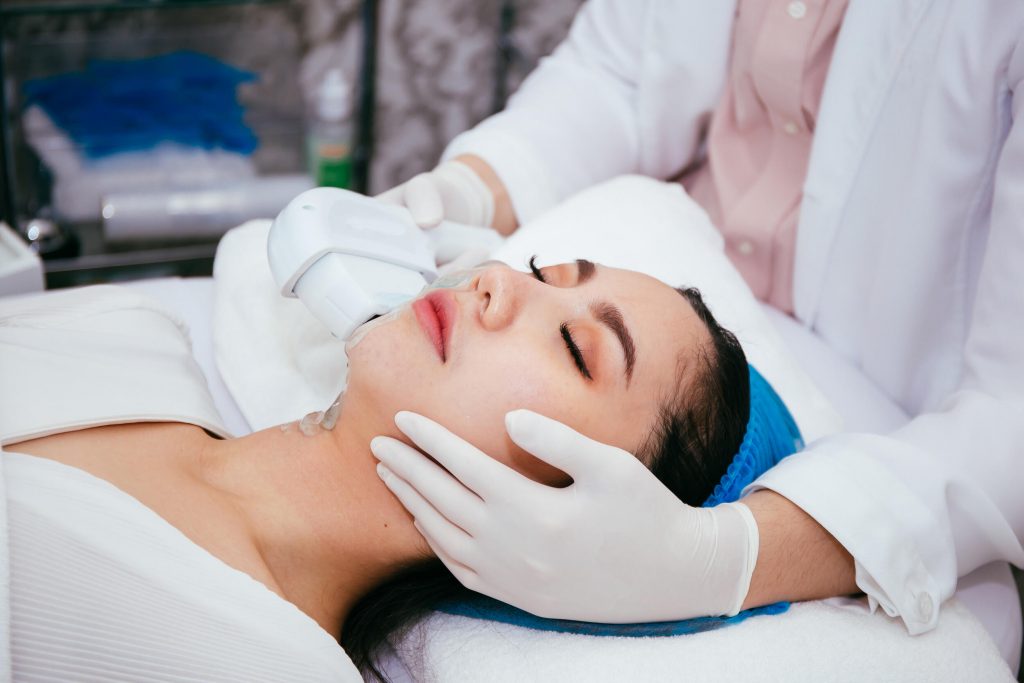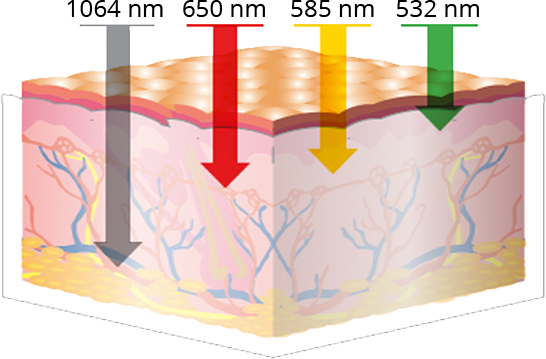Attain Clear Skin with PICO Laser
Our skin becomes discoloured or is affected by pigmentation for various reasons beyond our control: too many days out in the sun cause freckles or sunspots, while bouts of stress, or changes in our hormonal levels, or tweaks in our diets, may cause breakouts which lead to scarring.
But there’s some reason to rejoice—having crystal clear skin may not be as elusive as we might think. Technological developments have now made it possible for skin irregularities to be corrected through a safe, effective, and relatively painless procedure so we may all achieve the beauty ideal of having fresh, clear rejuvenated skin.
At Nuffield Aesthetic Clinic, we use the latest technology—The Fotona StarWalker PQX of PICO Fractional laser system —to treat a wide variety of skin conditions. It is used for purposes such as skin rejuvenation, brightening, pigmentation removal, acne, pore minimization, wrinkle reduction, as well as for tattoo removal.

The PICO fractional laser system involves delivering laser beams at a rate calculated in picoseconds. The energy from these laser beams is absorbed by pigmentation particles which are consequently broken down into minuscule particles—small enough to be removed by the body’s immune system.
Melanin, the pigment that gives skin its colour, is also the pigment responsible for producing darkened spotting. It absorbs the laser energy in a way that’s different from blood or water, the other components of the skin. What this means is that the energy delivered by the Pico laser targets the pigmented spots, and minimises damage to surrounding healthy skin cells.
During the procedure, coloured particles are splintered into numerous tiny particles. Macrophages, a type of cell that detects, engulfs and destroys organisms evaluated by the body to be harmful, latch onto these particles and kill them through a process called phagocytosis.In this way, pigmentation is removed from the surface of the skin, reducing its effect, leaving your complexion clearer and more even-toned.
PICO lasers, or Picosecond lasers, fire at faster and stronger pulses than Nanosecond lasers, commonly known as Q-Switched lasers. They fire at a rate calculated in picoseconds, 10 times faster than the traditional Q-Switched lasers. To put things into perspective that’s one-trillionth of a second—a rate that’s incomprehensible to the human eye and mind!
This newer technology solves two problems: minimises damage to surrounding areas and ensures particles are successfully broken down to small enough particles.
Because PICO lasers fire at such a fast rate, the duration in which the surrounding tissue areas are exposed to the light beams is negligible and therefore—damage to these areas is minimised. The shorter pulses also generate more effective photoacoustic effects in the treatment of stubborn pigmentation, while longer pulses produce more photothermal or photochemical effects—and therefore more heat or the stimulation of chemical reactions.
This is why updates to this laser technology procedure have lowered risks for side effects like post-inflammatory hyperpigmentation.
Another benefit of the newer PICO lasers is that they deliver much more energy per firing than Nanosecond lasers. So each session produces better and faster results, and the fewer total number sessions are needed for optimal results.
Using PICO lasers to treat wrinkles is especially suitable as it’s a non-ablative treatment.
Unlike ablative CO2 resurfacing laser treatments that cause burns to the topmost layer of the skin (epidermis), non-ablative treatments are highly targeted and aim to deliver heat to deeper layers of the skin.

PICO laser machines direct heat to deeper layers of the skin (dermis), while leaving the surface of the skin untouched. This heat creates micro-wounds that in turn stimulate the production of collagen, the protein that provides structure to the skin—smoothening out fine lines and wrinkles. This gives skin its fresh, plump, youthful look.
Here’s another plus of the updated fractional PICO lasers: they can be used to stimulate collagen in the treatment of acne scars and skin rejuvenation, in a way that Nanosecond lasers aren’t able to.
PICO lasers use a fractionated lens with a diffractive holographic optic, and so are able to create cavitation and plasma formation in the dermis. This allows for the fragmentation of inferior quality collagen that’s found in scars, and the activation of the formation of new collagen for scar remodelling.
Progressive treatments allow remodelling of poor collagen matrix in aging skin or fibrosis of the scar, improving the skin texture for the treatment of acne scarring and skin rejuvenation.
When the laser beam is directed to the skin, tiny globules of air form—a process commonly known as a light-induced optical breakdown. Collagen production is stimulated by the laser pulses, and fills these bubbles, pushing up the skin, reducing the depth of the pores or pitted acne scars.
Different types of scars from when acne heals and each must be treated differently.
Pitted acne scars cause depressions to the skin layer while keloid acne scars cause skin to be raised and for small bumps to be formed. Pitted acne scars include rolling, ice-pick, and boxcar scars. Both pitted and keloid acne scars also differ from the type of acne scarring that causes skin discolouration—where the texture of the skin remains unaffected, and only skin tone is altered in affected areas.
While discolouration and pitted acne scars can be treated with PICO lasers, it is only possible for the coloured component of keloid scars to be treated this way, but not the overgrowth of scar tissue.
During the treatment, when the laser is directed to the face and energy is released in pulses through a thin handpiece, a mild prickling sensation may still be experienced.
It’s important to note that the number of sessions depends on the existing condition of your skin.
The duration of each session is also dependent on the objective of the treatment, and the type of PICO laser and consequent wavelength used.
A PICO laser session that’s targeted to treat pigmentation, for toning and brightening, should last for about 10-20 minutes. This procedure is almost painless and no numbing is required.
Fractionated PICO laser, on the other hand, requires a more aggressive approach, where numbing is recommended prior to the treatment to minimise the sensation of the laser. This procedure lasts for 30-45 minutes. It is important that your doctor is able to discuss your treatment plans and set realistic expectations.
| PQX | Picosure | Picoway | Picoplus | Picodiscovery | |
| Type of compound used | Nd:YAG | Alexandrite | Nd:YAG | Nd:YAG | d:YAG |
| Peak Power (gw) | 2.7 | 0.36 | 0.9 | 1.8 | 1.8 |
| Pulse Duration (Picoseconds) | 300 | 750 | 450 | 450 | 450 |
No one machine is better than the other—each has its strengths and based on the type of treatment required, one machine may perform better in certain regards.
The Fotona StarWalker PQX is particularly safe and effective in treating heavily pigmented skin or the removal of tattoos, as it has a short pulse duration of 300 picoseconds and a high power of 2.7GW. With a short pulse duration, the exposure of energy to the surrounding tissue is minimized. With a high peak power, pigmentations can be effectively broken down to smaller particles. It has different wavelengths that can help target different skin problems are different depths.

The PICO treatment using The Fotona StarWalker PQX comes with minimal downtime and mild redness as compared to regular laser treatments for pigmentation and other related skin issues.
Compared to a QS Nanosecond laser, for Picosecond lasers, energy is delivered at a faster rate, less ‘heat’ effects result and that translates to a more comfortable treatment, and one that’s relatively painless.
Mild erythema, lasting several hours to one day, is common amongst most patients who have undergone this treatment. For the treatment of epidermal pigmentations however, it’s more common to experience 3-5 days of downtime.
Fractional PICO laser results in petechiae, pin-point bleeding under the skin, which self-resolves in 2-3 days. In a more aggressive setting, there may be scabs that form post-procedure, which would require a recovery period of 5-7 days.
For post-procedure care, it is recommended that skin is kept moist and for sunscreen (SPF 50+) to be worn when outdoors. The treated area also should not be exposed to intense heat or extreme cold. Skincare with irritants such as perfumes, acids, topical retinoids and other exfoliating agents should also be avoided. Skin care containing retinoid or hydroquinone may be resumed about 5-7 days after the treatment.